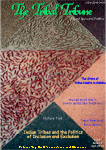Reinventing Baul: Performance and Discourse
| Abstract | Texture of Baul Songs |
| Introduction | Baul songs as social discourse |
| Instruments used by Bauls | Impact on the Audience |
| Place of the Baul songs | Conclusion |
Abstract
Various aspects of Baul music that span from its origin to impact are discussed. The richness of Baul songs is highlighted. Views that differ from some common perceptions about Baul songs are presented.
Introduction
Baul music is a part of Bengali traditional philosophical music, unique to Bangladesh and West Bengal of India. It was immensely popular in the 19th century and the early 20th century and its popularity can be felt in even in the 21st century. Basically Baul songs passed down in both the Bengal as an oral tradition by incorporating unique philosophy of thought, performance and social discourse. Baul tradition of Bengal is regarded as a fusion of the essence of Buddhism, Hinduism and Sufism taken together. Baul songs have their unparalleled feature, as they are the amalgamation of song, dance and narrative. Baul performer plays his musical instrument (Ektara, Duggie), singing and dancing at the same time. Baul poems are composed in the Bengali dialect, and celebrate the boundless love for mankind on a larger form. Baul ideas or thoughts are turned into poetic shape and posited in a domain that stands between philosophy and poetry, music and dance. Baul poem’s language is non conventional, it is an esoteric language, the Sandhya Basha, in which the common language and symbols are stripped of their natural meaning and conceal a profound mystic meaning. According to the poet laureate Rabindranath Tagore "One day I chanced to hear a song from a beggar belonging to the Baul sect of Bengal…What struck me in this simple song was a religious expression that was neither grossly concrete, full of crude details, nor metaphysical in its rarefied transcendentalism…”(Tagore, 1931)

It may be noted that the Bauls sing, dance and perform at the same time in course of their performance .So it is not just a song like other songs, in addition it displays all the rhythms of the mind soul and physical essence by providing a deep philosophy of thought which goes beyond language, religion and borders. They essentially present a story of narration regarding different philosophy related to psychology and physiology. Due to all these it becomes a global entity and its charm remains as fresh as the morning dew. In view of Baul songs assuming a character that is global, beyond language, region and border, the question arises as to if they can be classified as folk songs, which are dominantly regional. This question begs a separate study. But it may be appreciated that Bauls, who do not identify themselves as Hindus nor Muslims, are known for their iconoclasm; and do not observe any caste or social formalities. They love music, which speaks about human body as the microcosm and soul as an intangible bird. In fact they live a life, which is different from the common day-to-day way of living. Whatever be their original religious background, Hindu or Muslim, they have their own unique way of living. They are neither concerned about their lot tomorrow, nor they brood over their past. . They only live for the present moment. According to the Baul philosophy, present moment is the most precious moment in one’s life. Further any body can become a Baul and does not require any lineage. The only thing that one has to do is to adopt the Baul way of living.
Such being the tradition of Baul, not surprisingly many authors have undertaken various studies on different aspects of Baul (Dutt, 1932; Sen, 1954; Bandyopadhyay, 1957; Bhattacharya, 1957; Dimock, 1959; Bhattachaarya, 1969; Capwell, 1974: Dasgupta, 1976; Dasgupta & Dasgupta, 1977; Chakravati, 1980; Bhattacarya, 1989; Sarkar, 1990; Ray, 1994). Besides many discussions, personal interviews etc., on the Baul tradition are also found in various internet sources. (http://ruintears.blogspot.in/2010/12/turning-life-of-lalon-shai.html, accesed on 25th 2013; http://sos-arsenic.net/lovingbengal/lalon.html, accessed on 2nd January 2013; http://dir.groups.yahoo.com/group/BdOsint/message/7497, accessed on 4th March 2013; http://www.vancouverobserver.com/blogs/artsbeat/2011/08/02/parvathy-baul-brings- exhilarating-spiritual-music-vancouver., author is Jenny Uechi., accessed on 12th January 2013; http://www.india-forums.com/forum_posts.asp?TID=273413, accessed on 3rd February 2013)
The present paper contextualizes the essence of Baul songs from the perspective of its performance and narrative discourse, which includes the (i) reinterpretation of Baul from the perspective of its performance and social discourse,(ii) reinvention of Baul as social discourse focusing on social integration, plurality of religion and composite culture, (iii) reimaging of Baul songs as a text of ethical and philosophical values which can eradicate immoralty, violence and vehemence activities from the society in a larger whole, (iv) the effect of the Baul performance on the mind of the audience.
Eternal Entertainers
Bauls are bards, composers, musicians, dancers and actors all rolled into one, with the mission to entertain, and more than that to bring solace and peace of mind. Bauls are kind of mystic poet-singers with a unique way of life. They sing the song to communicate their philosophy to the people around the world Through their songs, pauses, gestures, and postures, these nomadic mendicants spread, far and wide, the message of love and ecstasy that goes beyond borders of time and space.
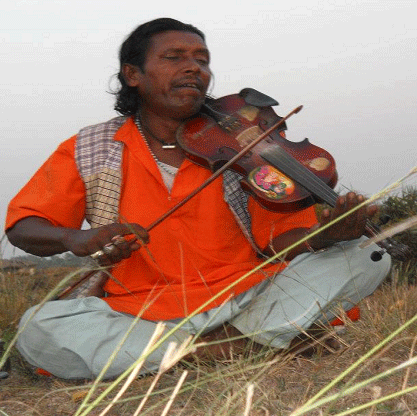
People love to watch them singing and dancing. Their commentary on contemporary issues via highly melodious songs is rendered in a high-pitched voice. Although their lyrics speak the language of the village folk, their songs appeal everybody. The people, well educated possessing intellectual disposition too are attracted by the thought and philosophy of Baul. Above all Baul songs are simple and direct, abundantly emotional, enjoyable, and needs no special knowledge for better understanding and comprehension.
The main characteristic of Baul music is that it had been passed down entirely in oral form until the end of the 19th century, when for the first that outside observers began transcribing it (Openshaw, 2004), though since early 18th century, Bauls had been identified as a major sect. In the context of the oral tradition of Baul music, poet Farhad Mazhar ,the leading intellectual on Baul philosophy, says “Philosophical discourse in Bengal, particularly of Bangladesh, is essentially oral. Music is not considered as a performing art, but a linguistic and metaphoric medium to create effects on people, helping them to open their hearts to listen to the call of the divinity that makes a person responsible to others.” (http://www.thekushtiatimes.com/11/04/2011/villagers-attack-lalons-followers-in-rajbari/)
The Bauls have been admired for their freedom from conventions, and for their music and poetry. Their music and poetry explore the relationship between God and man and promote spiritual freedom. Their merciful chants started in the fifteenth century when they appeared for the first time in the Bengali literature.
One of the recent world famous Baul performers is Parvathy Baul who is well trained in singing, dancing, and Baul philosophy. Parvathy Baul’s musical performances are hypnotic. Standing with a drum at her waist and an ektara (one-stringed drone) in one hand, her clear, soaring voice seems otherworldly and divinely inspired. On such performance she told following to her interviewer Jenny Uechi (http://www.vancouverobserver.com/blogs/artsbeat/2011/08/02/parvathy-baul-brings- exhilarating-spiritual-music-vancouver, accessed on 12th January 2013) .
“Music is closer to God — something that goes straight to God,” she said. “What we are really trying to do is, to stop the mind when we sing,” she said. “There is so much going on around, so many things happening at once, but inside, we (Baul singers) are calm.” Again She explained how Baul singers emphasize the “non-duality” between self and others, and how this is expressed in their performances. The Baul path is one of traveling, and very little material comfort. I don’t live the conventional life.”
Instruments used by Bauls

Baul songs are usually solo songs although often accompanists and members of the audience (normally, handful of villagers gathering around the Bauls) to join in the refrain and repetition phrases of the verse. Instruments used by Bauls include the following:
-
Khamak - A rhythmic instrument with one or two strings attached to the head of a small drum. The strings are plucked with a plectrum and they are alternatively tightened or slackened to generate an amazing array of rhythmic and tonal variations.
-
Tabla - A pair traditional Indian drums called 'baya' (the left hand drum) and the 'daina' (the right hand drum). The left drum has a clay based shell whilst the right drum has a wooden shell. Heads of both drums are covered in animal hide, the centre of which is applied with a layer of (dry) pulp mix. Tonal variation is achieved by adjusting tension of the skin head.
-
Mridanga or Khol - A barrel-shaped clay drum with two heads - sort of a combination of the baya and daina of tabla as described above.
-
Harmonium - A small keyboard instrument with hand-worked bellows - not unlike accordian.
-
Ektara - A plucked single string drone - fingers and thumb are used.
-
Khanjani - A tabourine without jangles.
-
Mandira or Kartal - Small bell-shaped cymbals.
-
Ghoongoor - A garland of bells tied around the ankle - played with rhythmic movements of feet.
-
Ramchaki - A pair of wooden clappers with jangles.
Place of the Baul song
Most of the time Baul songs are sung at the Akhras , that is in the open air near the village or in the field. Lately Baul songs have become so popular that they are now being performed on the stage raised in the fairs, and are also seen performed with the orchestra bands like Bolpur Blues, Oikyotaan etc.,. But earlier they didn’t have any particular place for singing, they could be seen everywhere such as in the trains, buses, field, shop and in the villages for madukari (begging) as Bauls primarily lived on madukari.
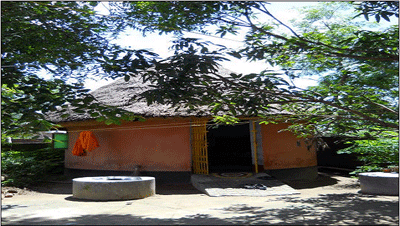
Texture of Baul Songs
At akhras, songs are sung in the style of hymn (song in praise of God), in a mellifluous voice and to a soft beat. At open-air functions Baul songs are, however, sung at a high pitch, to the accompaniment of instruments such as the ektara, dugdugi, khamak, dholak, sarinda, and dotara. Baul songs sung in the akhra are accompanied by dancing. Bauls may present songs singly or in groups. There is usually one main presenter; others join him for a chorus.
Baul songs are elegiac in tone, reflecting the pain of deprivation or longing for unknown bird (Achin Pakhi) and Man of the Heart (Moner Manush), which is unattainable. They are inspired by the idea that the human body is the seat of all truths, and by the search for a guru or Man of the Heart (Moner Manush). Every song may be interpreted in two ways: in terms of human love and in terms of divine love. Bauls refer to these two ways as the lower stream and the upper stream. Baul music reflects a conception of life. On the text of the Baul songs, Chakraborty, (2009) says, “The texts of the songs express all the essential ideas of their philosophy but in simple and vivid language. Sometimes the meaning is clear and easy to understand; sometimes a simple story has a profound, hidden meaning. This is because this particular philosophy requires a specialized understanding, a different setting. And to discern the meanings behind the words and the language of these songs needs a special experience. You cannot find these meanings by referring to a dictionary. For this, one must live amongst them, mix with them and penetrate their words by interacting with them.”
Baul songs as social discourse
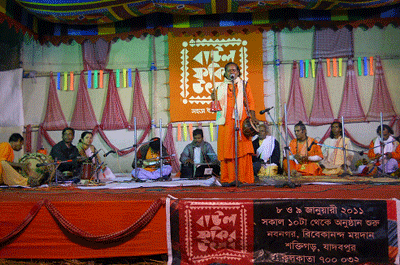
Baul songs can be the medium of social change and reformation. Basically baul songs carry earnest desire for new utopian society, where shall not exist any difference in human society be it cultural, religious or economic; this desired society shall be a society of mankind full of love for one another.. But that such a society is yet to come, their yearning for such society still continues. That is why they are always in search of Moner Manush (Man of the heart) and Achin Pakhi (The unknown Bird), which even thought of human mind and brain fail to conjure..
At a deeper level Baul songs deal with the tenets like (i) the sense of plurality in religion, (ii) fusion of religious and spiritual practices (iii) interfaith dialogue and (iv) the concept of composite culture.
Baul songs as discourse must be understood as multisemiotic form, in which words, music and performance conditions are all potentially significant, and can carry an ideological content that is often more important than the ostensible verbal meaning. As an illustration of this aspect of the Baul songs, a song by famous Baul singer Lalan Fakir entitled 'Khachaar Bhetor Achin Pakhi, Kamne Ashe Jae‘, (How an unknown bird flits in and out of a cage.) may be recalled whose few lines in translation read as follows.
Nobody can tell whence the bird unknown
comes into my cage and goes out.
Look, how a strange bird flits in and out of the cage!
O brother, I wish I could bind it with my mind in fetters.
Have you seen a house of eight rooms with nine doors
Closed and open, with windows in between, mirrored?
O mind, you are a bird encaged! And of green sticks
Is your cage made, but it will be broken one day.
Lalon says: Open the cage, look how the bird wings away!
Baul songs are still exerting their specific influence on the people and society. The Baul gatherings during various age-old socio-religious occasions are still spontaneous and highly effective. The Bauls still carry the message of love and integration. They are still very much vocal against social inequality based on caste and class, religious feuds, untouchabality and disintegration, and they continue to expose the futility of religious commotion and plead for a peaceful assimilation of all religions conditioned by love for humanity. They talk about humanity and brotherhood, spirituality and religion, peace and tranquility, love and mysticism and so on. Baul songs use simple words that carry deeper philosophical meanings involving the thoughts of Creation, society and human emotions, and suggesting a way of living. Both the lyrics and the music are ‘soul-searching’ that is trying to reach the innermost recess of the heart. They break away from many common beliefs and religious dogmas, including the age-old caste system, and the separation of Hindu and Muslim communities.
The lyrics in Baul music urge man to search for God within himself and condemn the role of mosques and temples in the quest of God. Baul music celebrates divine love in the form of physical love. This celebration of love is only attainable through union to his soul mate. With such a liberal interpretation of love, it is only natural that Baul devotional music transcends religion, national borders and language barriers. In a word it becomes a global precept for the benefit of whole generation.
Impact on the Audience
It is true that Baul songs impact the audience a lot. A kind of web is made in course of Baul songs .We can find different interaction at the time of Baul songs. First of all, interaction is made between the singer and the listener, secondly between listener to listener, thirdly between performer and his or her soul and fourthly between the performer and the God. It is said that during the performance the Bauls get a kind of force from the audience, which is the sole energy for their singing and meditation (Paban Das Baul during Joydev Mela 2012, personal communication).
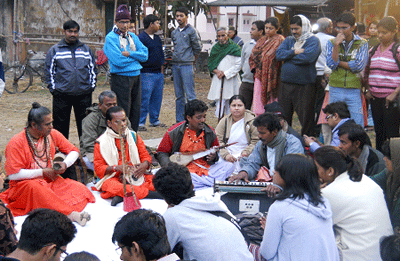
Conclusion
Baul songs are the heart and soul of the Bauls. Baul songs are the medium of communication for them. They communicate with the people with their songs. Apart from that Baul songs are the paths of their meditation or sadhana and sometimes it is the medium to communicate with God, Man of the heart and so on.
With the development of technology and communication Baul songs have flourished all over the world. A number of concerts are being organized in different parts of the globe. The conditions of the Bauls are changing in terms of prosperity, themes, beliefs and way of living. Sometimes they are violating their dress code and ethics of their philosophical bent of mind i.e. they sometime become professional by neglecting their own philosophical thought. An interesting development observed in Baul music is the adaptation to the use of the latest musical instruments instead of being restricted to the traditional Khamak, Mridanga or Khol ,Ektara Dugi and so on. Yet the old tradition of Baul continues and found predominantly performed in the districts like Khustia of Bangladesh and Birbhum, Murshidabad, Purulia, Nadia, Bardhaman of West Bengal in India. Recently, by virtue of their specific wordings, rhythm, tuning and mode of presentation they have attained a conspicuous place in the world of music. In paying tribute to the grandeur, depth and richness of Baul, the poet laureate Rabindranath had said, “Your flute could not have its music of beauty if your delight were not in my love. Your power is great -- and there I am not equal to you -- but it lies even in me to make you smile, and if you and I never meet, then this play of love remains incomplete”. (Tagore, 1931)
References
- Bandyopadhyay,Somen. (1957). Baul Songs of Bengal and Their Modern Forms in Study of Cahanges in Traditional Culture , Ed. By K.P. Chattopadhyay, University of Calcutta,
- Bhattacarya, Deben. (1989). Songs of the Bards of Bengal (trans.). New York: Grove Press.
- Bhattachaarya.D. (1969). The Mirror of the Sky: Songs of the Bauls from Bengal, London: George Allen and Unwin, Limited ,
- Bhattacharya, Upendranâth. (1957). Banglar Baul o Baul Gan. Calcutta: Orient Book Co.
- Capwell, Charles. (1974). The Esoteric Belief of the Bauls of Bengal. Journal of Asian Studies 33:255-264.
- Chakraborty, Sudhir. (2009.). Baul Fakir Katha. Calcutta: Ananda Publishers Private Limited.
- Chakravati, Surath Chandra. ( 1980). Bauls:The Spiritual Vikings. Calcutta: Firma K.L. Mukhopadhyay.
- Dasgupta, Shashibhusan, (1976). Obscure Religious Sects, Calcutta: Firma K. L. Mukhopadhyay.
- Dasgupta, Alokeranjan, and Mary Ann Dasgupta. (1977). Roots in the Void: Baul Songs of Bengal. , Calcutta: K. P. Bagchi.& Co.
- Dimock, Edward C., Jr.( 1959).. Rabindranath Tagore – The Greatest of the Bauls of Bengal. Journal of Asiatic Society 29 (1), 33-51.
- Dutt, G.S. (1932). The Folk Dances and Folk-Songs of Bengal. The Music Review, July, 44-52.
- Openshaw, Jeanne. (2004). Seeking Bāuls of Bengal, New Delhi : Foundation Books Pvt.Ltd.
- Ray, Manas.(1994). The Bauls of Birbhum: A Study in Persistence and Change in Communication in Cultural Context. Calcutta: Firma K.L. Mukhopadhyay.
- Sarkar, Rebati Mohan, ( 1990). Bauls of Bangal, in the Quest of Man of the Heart. Delhi: Gian Publishing House.
- Sen, Srîkshitimohan. (1954). Banglar Baul. Calcutta University.
- Tagore, Rabindranath. (1931). The Religion of Man,Being the Hibbert lectures for 1930.New York:Macmillan.


